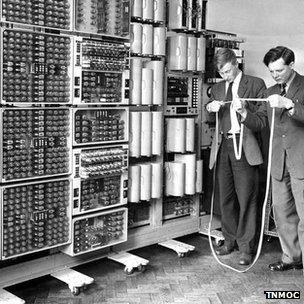Two-tonne Witch computer gets a reboot
- Published
Kevin Murrell who discovered the computer explains how it was brought back to life
The world's oldest original working digital computer is going on display at The National Museum of Computing in Buckinghamshire.
The Witch, as the machine is known, has been restored to clattering and flashing life in a three-year effort.
In its heyday in the 1950s the machine was the workhorse of the UK's atomic energy research programme.
A happy accident led to its discovery in a municipal storeroom where it had languished for 15 years.
Cleaning up
The machine will make its official public debut at a special ceremony at The National Museum of Computing (TNMOC) in Bletchley Park on 20 November. Attending the unveiling will be some of its creators as well as staff that used it and students who cut their programming teeth on the machine.
Design and construction work on the machine began in 1949 and it was built to aid scientists working at the UK's Atomic Energy Research Establishment at Harwell in Oxfordshire. The 2.5 tonne machine was created to ease the burden on scientists by doing electronically the calculations that previously were done using adding machines.

The machine cranked through the boring calculations atomic scientists once had to do
The machine first ran in 1951 and was known as the Harwell Dekatron - so named for the valves it used as a memory store. Although slow - the machine took up to 10 seconds to multiply two numbers - it proved very reliable and often cranked up 80 hours of running time in a week.
By 1957 the machine was being outstripped by faster, smaller computers and it was handed over to the Wolverhampton and Staffordshire Technical College (more recently Wolverhampton University) where it was used to teach programming and began to be called the Witch (Wolverhampton Instrument for Teaching Computation from Harwell).
In 1973 it was donated to Birmingham's Museum of Science and Industry and was on show for 24 years until 1997 when the museum closed and the machine was dismantled and put into storage.
By chance Kevin Murrell, one of the TNMOC's trustees, spotted the control panel of the Witch in a photograph taken by another computer conservationist who had been in the municipal store seeking components for a different machine.
Mr Murrell said that as a "geeky teenager" he had regularly seen the Witch during many trips to the museum and instantly recognised its parts in the background of the photograph.
On subsequent trips to the storage facility the various parts of the Witch were found, retrieved and then taken to the museum at Bletchley where restoration began.
The restoration effort was led by conservationist Delwyn Holroyd who said it was "pretty dirty" when the machine first arrived at Bletchley. Remarkably, he said, it had not suffered too much physical damage and the restoration team has been at pains to replace as little as possible. The vast majority of the parts on the machine, including its 480 relays and 828 Dekatron tubes, are entirely original, he said.
Said Mr Murrell: "It's important for us to have a machine like this back in working order as it gives us an understanding of the state of technology in the late 1940s in Britain."
- Published7 September 2012
- Published9 March 2012
- Published13 September 2010
- Published12 October 2012
- Published10 September 2012